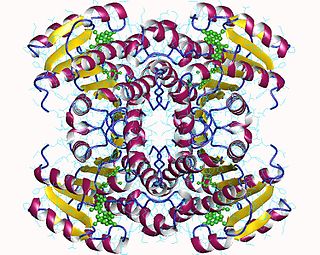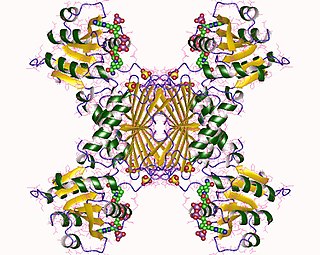Protein-disulfide reductase Last updated August 27, 2023 In enzymology , a protein-disulfide reductase (EC 1.8.1.8 ) is an enzyme that catalyzes the chemical reaction
protein dithiol + NAD(P)+ ⇌ {\displaystyle \rightleftharpoons } + The 3 substrates of this enzyme are protein dithiol , NAD+ , and NADP+ , whereas its 4 products are protein disulfide , NADH , NADPH , and H+ .
This enzyme belongs to the family of oxidoreductases , specifically those acting on a sulfur group of donors with NAD+ or NADP+ as acceptor. The systematic name of this enzyme class is protein-dithiol:NAD(P)+ oxidoreductase . Other names in common use include protein disulphide reductase , insulin-glutathione transhydrogenase , disulfide reductase , and NAD(P)H2:protein-disulfide oxidoreductase .
Related Research Articles Dicarbonyl/L-xylulose reductase , also known as carbonyl reductase II , is an enzyme that in human is encoded by the DCXR gene located on chromosome 17.
In enzymology, a carbonyl reductase (NADPH) (EC 1.1.1.184 ) is an enzyme that catalyzes the chemical reaction
In enzymology, a 3-hydroxyacyl-CoA dehydrogenase (EC 1.1.1.35 ) is an enzyme that catalyzes the chemical reaction
In enzymology, a 3-oxoacyl-[acyl-carrier-protein] reductase (EC 1.1.1.100 ) is an enzyme that catalyzes the chemical reaction
In enzymology, a 3-oxoacyl-[acyl-carrier-protein] reductase (NADH) (EC 1.1.1.212 ) is an enzyme that catalyzes the chemical reaction
In enzymology, an enoyl-[acyl-carrier-protein] reductase (NADPH, A-specific) (EC 1.3.1.39 ) is an enzyme that catalyzes the chemical reaction
In enzymology, a long-chain-fatty-acyl-CoA reductase (EC 1.2.1.50 ) is an enzyme that catalyzes the chemical reaction
In enzymology, a ferredoxin-NADP+ reductase (EC 1.18.1.2 ) abbreviated FNR , is an enzyme that catalyzes the chemical reaction
In enzymology, a ferredoxin–NAD+ reductase (EC 1.18.1.3 ) is an enzyme that catalyzes the chemical reaction:
In enzymology, a rubredoxin—NAD(P)+ reductase (EC 1.18.1.4 ) is an enzyme that catalyzes the chemical reaction
In enzymology, a rubredoxin-NAD+ reductase (EC 1.18.1.1 ) is an enzyme that catalyzes the chemical reaction.
Bis-gamma-glutamylcystine reductase (EC 1.8.1.13 ) is an enzyme that catalyzes the chemical reaction
In enzymology, a CoA-disulfide reductase (EC 1.8.1.14 ) is an enzyme that catalyzes the chemical reaction
In enzymology, a CoA-glutathione reductase (EC 1.8.1.10 ) is an enzyme that catalyzes the chemical reaction
In enzymology, a mycothione reductase (EC 1.8.1.15 ) is an enzyme that catalyzes the chemical reaction
In enzymology, a protein-disulfide reductase (glutathione) is an enzyme that catalyzes the chemical reaction
In enzymology, a pyrroline-5-carboxylate reductase (EC 1.5.1.2 ) is an enzyme that catalyzes the chemical reaction
In enzymology, a trypanothione-disulfide reductase (EC 1.8.1.12 ) is an enzyme that catalyzes the chemical reaction
In enzymology, a 4-hydroxy-tetrahydrodipicolinate reductase (EC 1.17.1.8 ) is an enzyme that catalyzes the chemical reaction
Dissimilatory sulfite reductase is an enzyme that participates in sulfur metabolism in dissimilatory sulfate reduction.
References
Activity Regulation Classification Kinetics Types
This page is based on this
Wikipedia article Text is available under the
CC BY-SA 4.0 license; additional terms may apply.
Images, videos and audio are available under their respective licenses.






